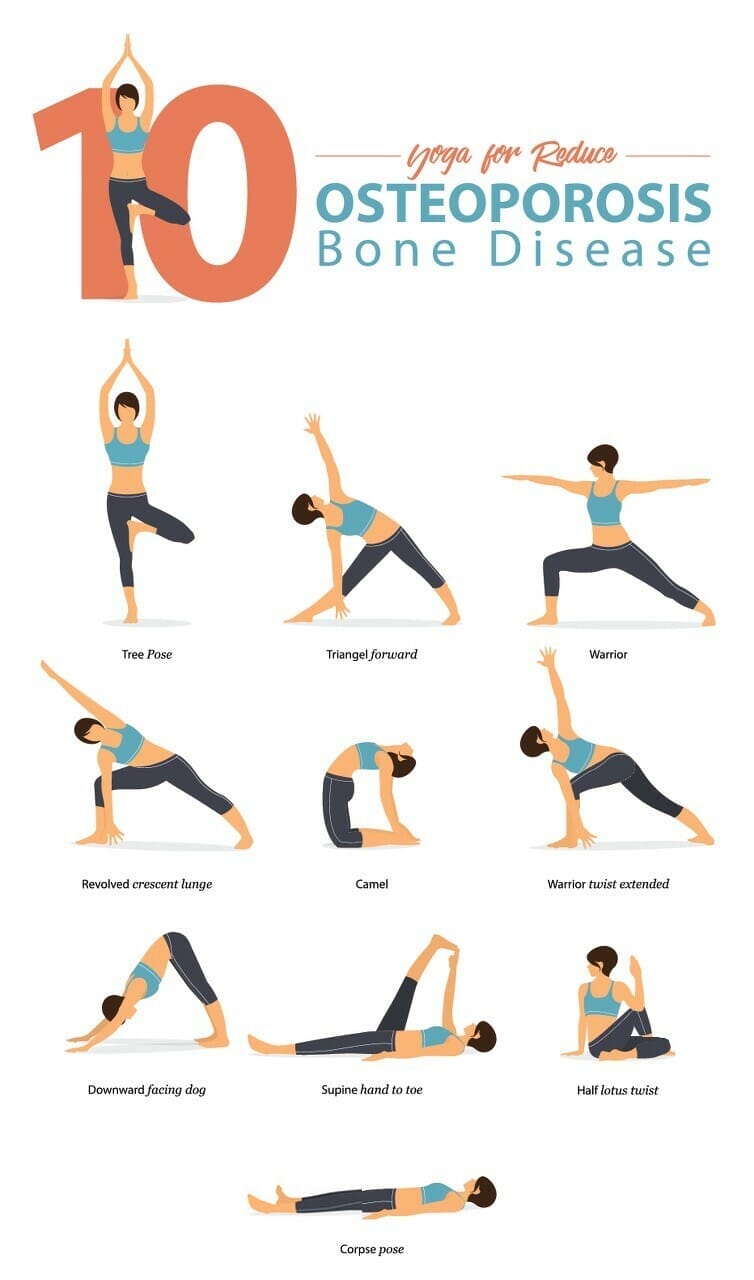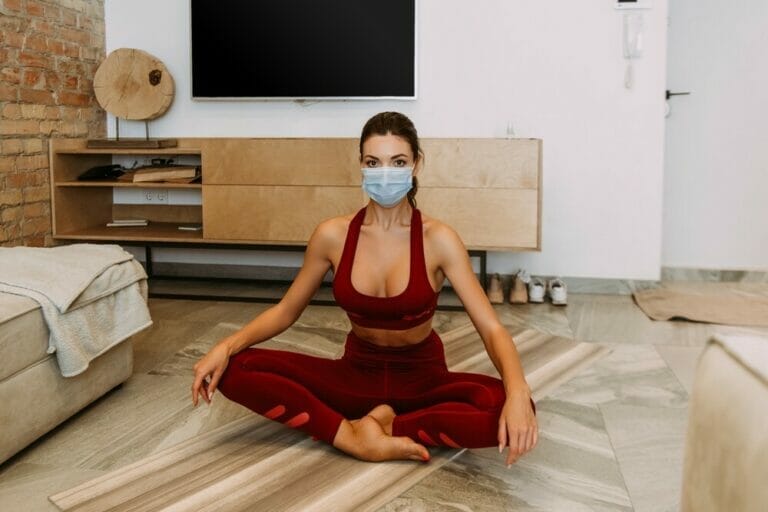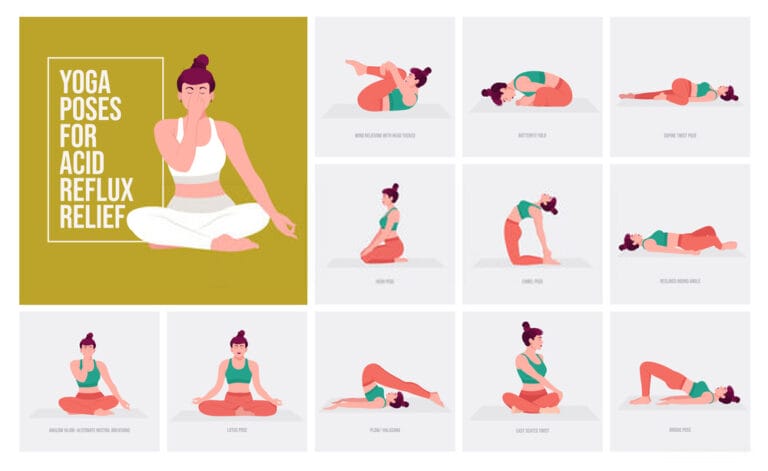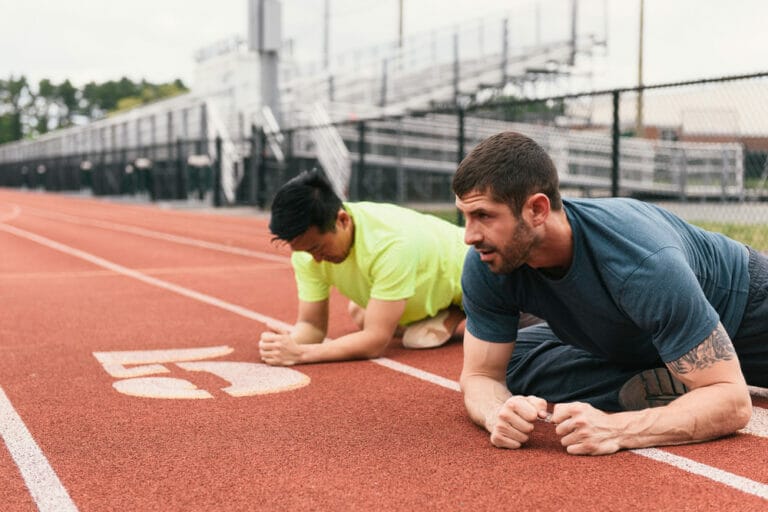Suffering From Osteoporosis? – These 12 Yoga Poses Will Help
Yoga is an excellent way of improving your osteoporosis treatment. It can aid in relieving symptoms, developing bone health, and reducing the risk of problems. In addition, after menopause, yoga may help to improve bone density.
Let us see what we mean by osteoporosis and how yoga helps in treating it.
What is osteoporosis?
Osteoporosis is a chronic disease causing the bones to become fragile. It occurs when bone mass decreases at an accelerated rate, resulting in smaller, more fragile bones.
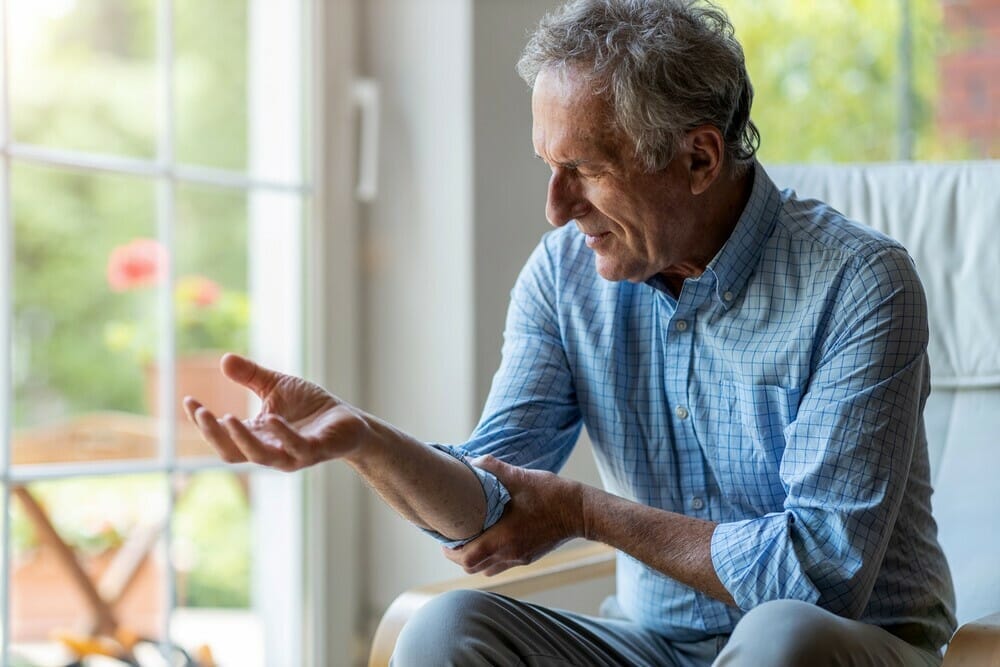
With age, both men and women lose bone mass at an average rate. However, osteoporosis causes these losses to be more significant than usual.
Eventually, these losses occur at such an alarming rate that the skeleton can no longer supply enough minerals to meet our body’s needs. The result is weakened bones and irreversible fractures (for example, hip fractures).
How does yoga help in osteoporosis?
- Yoga helps in building muscles. Strong muscles support your bones and prevent the process of bone loss.
- Yoga helps to improve balance and flexibility. It helps you maintain your balance and prevents sudden falls that may lead to fractures or injury to joints and the spine. It also relieves pain caused by other osteoporosis symptoms.
- Yoga helps relieve stress, which is a side effect of other treatments for osteoporosis like medicines.
- Preventing and treating osteoporosis: Yoga can help prevent and treat osteoporosis by building muscle, maintaining balance, relieving pain, reducing weight, and maintaining healthy body weight.
That’s why it is essential to include yoga and other physical activities in your treatment plan for osteoporosis.
Dr Loren Fishman has developed a routine with 12 yoga poses for osteoporosis, which you can do at home for better bone health. Let us look at the twelve yoga poses that will help prevent and treat osteoporosis.
Tree pose – Vrksasana
Benefits: This pose promotes balance, posture, and attention while strengthening the legs and hips.
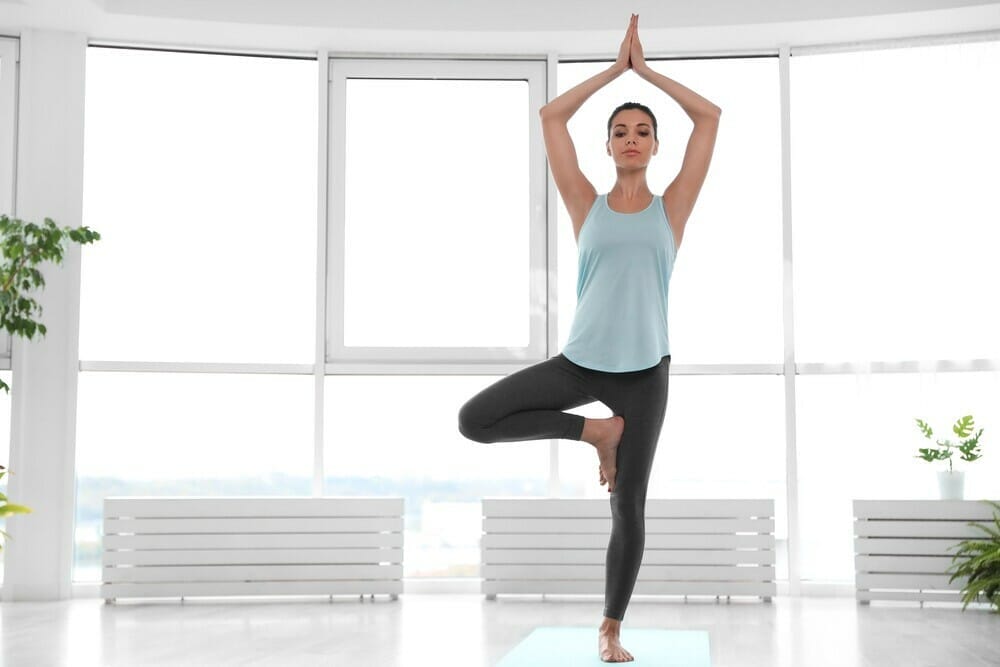
Avoid this pose if you have a severe rotator cuff injury. Also, if you have trouble keeping your balance, you may want to skip this posture or modify it to fit your requirements.
Props: To execute the osteoporosis variant of this position, you’ll need a wall and a chair.
Tip: Putting too much or too little effort into this position can make it more challenging to balance. Strike a balance between the strain of muscles on your bones and the expansion of your body from the centre out via your arms and legs.
Triangle pose – Trikonasana
Benefits: The greater trochanters (part of the upper thigh bone), anterior lumbar and posterior thoracic vertebrae (upper and lower spine), and pubic bones are all stressed in this posture. It aids in the development of stamina, attention, and balance.
If you have Achilles tendonitis, advanced hip arthritis, knee arthritis, ligamentous knee injuries, a recently herniated disc, or a pubic fracture, you should avoid this position.
Props: For the osteoporosis variety, you’ll need a yoga mat, a chair, and a wall; for the osteopenia variation, you’ll need a yoga block and a wall.
Tip: The broader your stance, the more hip mobility you’ll have. But don’t go too wide, or you’ll lose your balance!
Warrior II – Virabhadrasana II
Benefits: The femur and pelvic bones are stimulated in this position. Hip mobility, balance, and leg strength are all improved as well.
You should avoid or alter this posture if you have any of the following conditions: A sacroiliac joint derangement, adductor tear, Achilles tendonitis, anterior cruciate ligament injury, chondromalacia patellae, plantar fasciitis, or chondromalacia patellae.
Props: A wall, chair, yoga mat, and a block.
Tip: If you’re tall, consider putting a cushion or block under the chair seat to raise it. Point your kneecap toward your second toe to align it.
Side angle pose – Parsvakonasana
Benefits: Stimulates the entire skeleton, including central and peripheral.
You should avoid this pose if you have-
- Carpal tunnel syndrome
- Coccygodynia
- Intervertebral disc herniation
- Ischial bursitis
- Shoulder or hip labral tear
- Spinal vertebral fracture
Props: A yoga mat and a chair are required. Perhaps a blanket or a block.
Tip:
- Make any required adjustments to this position based on your height.
- Place a block beneath your front foot if it doesn’t reach the floor comfortably.
- Place a folded blanket on the chair seat if you’re tall.
Twisted triangle pose- Parivrtta Trikonasana
Benefits: The hips, anterior lumbar, and posterior thoracic vertebrae are all stressed in this position (upper and lower spine). It aids in the development of flexibility, concentration, and balance.
You should avoid this posture if you have any of the following conditions: Achilles tendonitis, severe hip arthritis, knee arthritis, ligamentous knee injuries, a recently herniated disc, or a pubic fracture are all possible causes of pubic fracture.
Props: A yoga mat. For the osteoporosis variety, a chair and a wall, the osteopenia variation, a block, and a wall.
Tip: Try rotating your pelvis in the twist’s direction. It will allow you to get the most out of the wrench while keeping your spine long.
Locust pose – Salabhasana
Benefits: Improves posture by strengthening the spine and shoulder muscles. The vertebrae are stimulated.

If you have a recent or chronic back or neck injury, you should probably avoid this position.
Props: You may require a yoga mat and a blanket.
Tip: This posture may cause your lower back to feel squeezed. To avoid this:
- Pull your ribs and upper back forward and lengthen your tailbone and legs away from your lower back.
- If you’re still getting a pinch, don’t go as high.
- Come up slowly and only as far as you feel comfortable!
Bridge pose – Setu Bandha Sarvangasana
Benefits: Strengthens the lower spine, core, buttocks, hamstrings, and deep inner hip stabilizer muscles.
You should avoid this posture if you have any of the following conditions: Facet syndrome, sacroiliac joint derangement, scoliosis, spinal stenosis, spondylolisthesis, and spondylolysis are all examples of Arnold-Chiari malformations.
Props: You may require a yoga mat, a blanket, and a belt.
Tip: Maintain a parallel line between your legs and feet. As you breathe, relax your neck, throat, and jaw. Squeezing your buttocks too hard or pushing your arms towards your feet are also bad ideas.
Supine hand-to-foot I – Supta Padangusthasana I
Benefits: Stretches the hamstrings and hips gently and securely. The hips become more flexible as a result of this.
If you have an injury to your hamstrings, quadriceps, or shoulders, you should probably avoid this position.
Props: A yoga mat, a chair, a blanket, and a belt.
Tip: To get the most out of this posture, make sure your legs are fully engaged.
Supine hand-to-foot II – Supta Padangusthasana II
Benefits: Stretches your hamstrings, calves, and inner thighs gently and safely. As a result, hip flexibility is increased, and the pelvis is aligned.
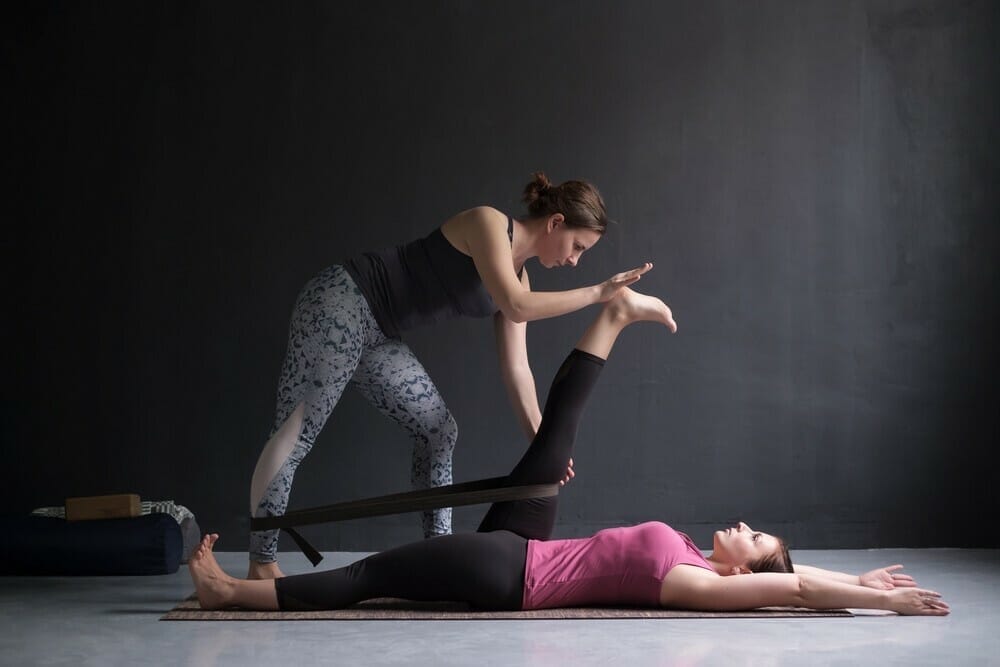
Props: The same as in Supine I.
Tip: Maintaining your hips looking forward while twisting your leg out to the side is the most challenging element of this position. Make sure your abs are active and your bottom thigh is grounded into the floor or chair to assist you in achieving this.
Straight-legged twist- Marichyasana II
Benefits: The lumbar and thoracic vertebrae (lower and upper spine), shoulder joint, and femurs are all stressed and strengthened. It teaches you to stay focused and relaxed while you’re under pressure.
If you’re at risk of dislocating your shoulders or hips, have severe shoulder arthritis, or have a recently herniated disc, you should avoid this position.
Props: You will require a chair, a yoga mat, and a blanket.
Tip: Keep your alignment in mind when twisting this way, even if it means you don’t twist as far. To avoid going too far with the twist, go into it with full awareness.
Bent-knee twist- Matsyendrasana
Benefits: This position applies resistive stress to one side of the skeleton at a time. It stretches the back muscles and improves spinal and vertebral mobility.
You should avoid this pose if you have Colostomy, herniated lumbar disc, rotator cuff rupture, spondylolisthesis, or vertebral fracture.
Props: A yoga mat, a chair, a wall, and a blanket.
Tip: Before spinning, always extend your spine upward. Twist while rooting down through your pelvic bones and using your abdominal muscles to assist you.
Corpse pose – Shavasana
Benefits: This pose allows you to unwind and contemplate after a strenuous session thoroughly.
This position is not recommended for women who are late in their pregnancy.
Props: A yoga mat, blankets, and eye protection.
Tip: In this posture, avoid fussing or fidgeting beyond the first setup. Allow your body to relax and your thoughts to calm down to get the most out of your session.
Bottom line
Yoga is a fantastic way to control osteoporosis symptoms. In addition, consistent practice can strengthen your muscles and bones, reducing your chance of injury and falling.
Choose yoga positions that will help you gain strength without pushing yourself too far. Pay attention to your body and make adjustments as needed.
Before beginning a regular yoga practice, see your doctor. They can advise you on the best and worst postures to take. Then, incorporate yoga into a healthy lifestyle to maintain healthy bones well into old age!

